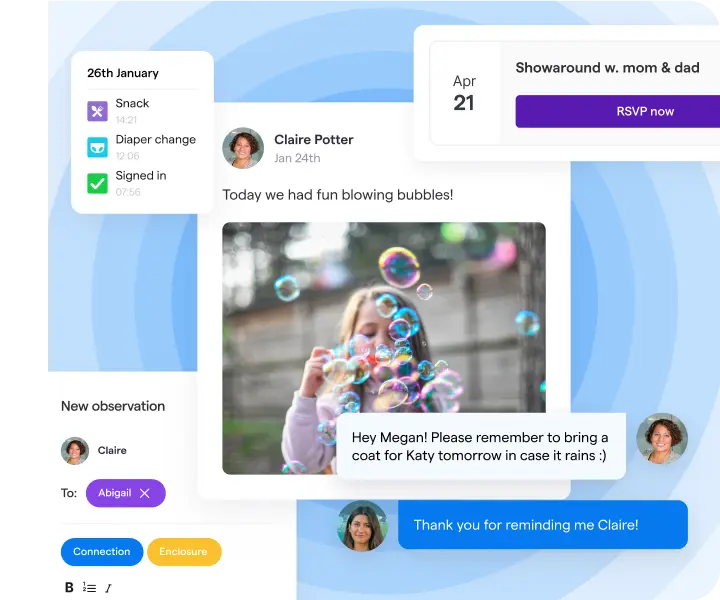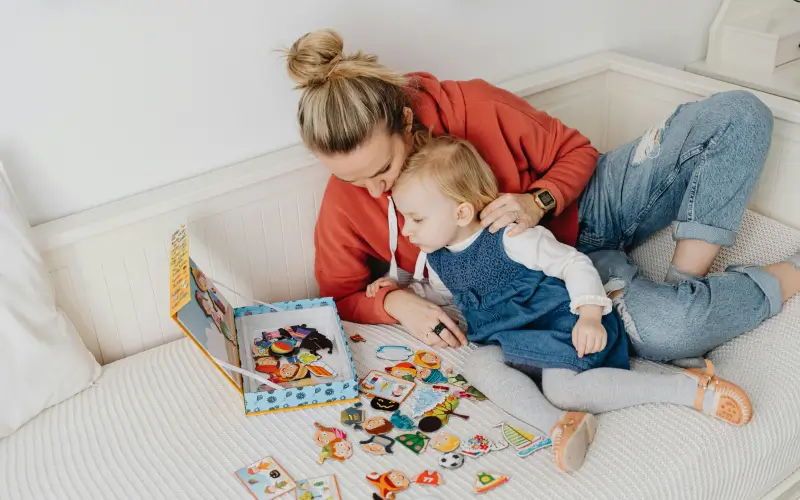settings
children
With Famly since
Family engagement, parental involvement, parent partnerships. There’s a lot packed into those two word phrases.
Collaborating with families is key to a whole-child approach but constant feedback and oversight from families is distracting. And recent Famly survey findings show that 89% of childcare directors want more engagement with families, even though 38% of childcare directors feel that their families are overbearing, causing distractions.
It’s like a math problem from the SATs. If Y, and Z, then how do you solve for X:
If families want to be a part of their child’s growth and development, and staff want families to be a part of their child’s growth and development—but families often distract staff, which also takes away from the children, negatively impacting their growth and development. So then, how do we find the balance between giving families visibility they are happy with without distracting educators from teaching?
Math was never my strongest subject, so I invited Stephanie Deputy from WatchMeGrow, and a former preschool director, to dive into the complexities of parent engagement, and to get some first-hand tips on how to solve for that equation.

How do you keep good communication with your parents?
Here’s what Stephanie shared as her pro tips as a previous director on how to build family members' trust
- Have clear communication channels like direct messages in your childcare management software or childcare app, phone calls, office hours, and parent-teacher conferences.
- Be empathetic - Families feel heard when you take the time to listen and internalize their concerns. As Steph says, “Even if you've heard it a thousand times before, giving the family that time when it's something that's really important to them,” means a lot to them and is the foundation of building a trusting partnership.
- Request feedback - Send out parent surveys to show you prioritize their input, and it provides space for anonymous feedback. Of course, remind them that they can always schedule a meeting with you if necessary.
- Be resolution-oriented - Listen with the intention of finding a solution that you and the parents agree on. This will give a clear way forward to address the issue they’ve raised, and gives action points to follow up on to confirm that it has been resolved.
- Be consistent - Consistently follow through on the agreement, resolutions and expectations that you’ve set.
- Share photos and videos because they’re worth a thousand words, bring smiles, and are a real snapshot into their child’s day. Also, with the required permissions, it does open the possibility of allowing families to see who their child is spending their days with. Who is my child’s best friend, Erica, that he’s always talking about? This helps strengthen the community overall.
The big ideas

What is key to good relationships with parents?
Stephanie mentions that “the best defense is offense.” In other words, building positive relationships with parents starts the first day you meet.
When families meet you for the first time, they’ll share what’s most important to them about their child’s health, growth and development. Knowing and “understanding what those concerns are early on in the relationship will help you build a strong relationship for that family.”
After listening, make sure to explain your communication process, so they have clear expectations of you and your staff.
- How: Let them know what channel you’ll communicate through most often when sharing information about their child. For instance, through private messages in your childcare app.
- When: What time of day will you communicate? For instance, during nap time, or at the end of the day when the children have left?
- What: What type of information can they expect to get? Will it be daily activity logs, observations, photos, or an overview of progress and development?

Tips to proactively build trust
Plus, use these tips to strengthen your partnerships. You can have these set-up and ready to go even before you’ve met.
- Make sure your Parent Handbook is updated and extensive with a clear overview of your policies and procedures. Share this with the families before their child starts their first day, and make sure to keep it somewhere easy to find.
- Post your center-wide events and updates where the whole community can see. Maybe on a bulletin board by your center’s entrance or admin office. . Seeing this will instantly make families feel welcomed into their new community. And don’t forget to share those updates digitally on your childcare app’s newsfeed.
- Be consistent with a monthly Newsletter, so families always know when they can expect updates, overviews, and important upcoming information.
- Address common challenges and misunderstandings upfront. For instance,
- What are your most commonly asked questions? Keep those in an easily accessible place (like your newsfeed or parent handbook)
- Are there parents who constantly provide “constructive criticism” or feedback on how to interact with their child? To minimize getting more of that, remind new families of the parent survey forms, and encourage them to book an in-person meeting, so that it can be discussed clearly, directly and with the goal of creating a solution.
This is a perfect segue to the popular question…
“Calls like this are usually around separation anxiety and parents just getting comfortable with being away from their kids and somebody else doing all the things…It's a new situation”
How do you deal with helicopter parents?
- Understand the deeper issue - When a parent is constantly calling, even about the smallest things, like “My child is wearing the green hat, and I sent them with a blue hat that day to school,” take a step back and figure out what is fueling this comment. As Steph explains, “Calls like this are usually around separation anxiety and parents just getting comfortable with being away from their kids and somebody else doing all the things…It's a new situation”
- Most of the time, they want to be heard and acknowledged. Remind them that you remember what you’ve talked about before, and you know what their primary concerns are. This will reassure them.
- Err on the side of over-communication in the beginning to help calm their nerves, and provide reassurance. A new situation is scary for anyone, but especially for families who are not used to leaving their children in someone else’s care.
- Directors need to equip their staff too. Office hours should be open to not only parents, but also staff to discuss common concerns, and equip them with tools on how to handle those situations. Many times, parents approach their child’s teacher with concerns before going to the director, so it’s important to support the teachers in those situations. As Steph says, “make sure that staff is trained for consistency, so they're able to respond with the same professionalism and empathy and listen just as well as the director is doing.”
- Give them best practices. If you have a digital platform with livestream video feed for families, be sure to share the best ways to ask questions or concerns based on what they see. Encourage them to use features that your video provider offers, like WatchMeGrow’s live reactions.

-
How do you know when you’re trusted?
So, how do you know when parents are more confident in letting you do what you do best? Or, in parent-teacher partnership terms, how do you know when “you’ve made it?”
Stephanie’s answer?
“I know we have a great relationship, where they really view us as a partner, that really is focused on what's best for their child [when]...they are not calling me for every little decision that needs to be made...Even more, when they go a step further and ask for your advice" around some behaviors or situations at home.
Tools can help you strike the right balance
At the end of the day, families want to feel confident, informed, and included. And educators want the space to teach, connect, and care without constant interruptions. The real challenge—and the real opportunity—isn’t choosing one over the other. It’s building systems, routines, and relationships that support both. That starts with trust, which comes from clear expectations, consistent follow-through, and honest, proactive communication.
In our digital age, there are a variety of communication tools that encourage positive relationships and parental involvement. With the right tools, and thoughtful leadership, you can create a culture where families feel like partners, and where teachers feel supported - where communication is accessible and brings the community closer.
With Famly and WatchMeGrow working together, you’ll be able to:
- Send messages that reach families instantly without interrupting class
- Communicate professionally with Sidekick's help, even when you're rushed
- Share with families in their own language, so everyone feels included
- Capture and share those special learning moments the right way
- Keep everything safe and secure, giving you peace of mind
This is just an abbreviated list of the tips Steph provided. Watch the full conversation on striking the balance of fostering parent engagement and maintaining boundaries.
Your personal writing assistant
Fix spelling, grammar, and improve the tone of every message and newsfeed post. All with Sidekick.
Learn how Sidekick works










